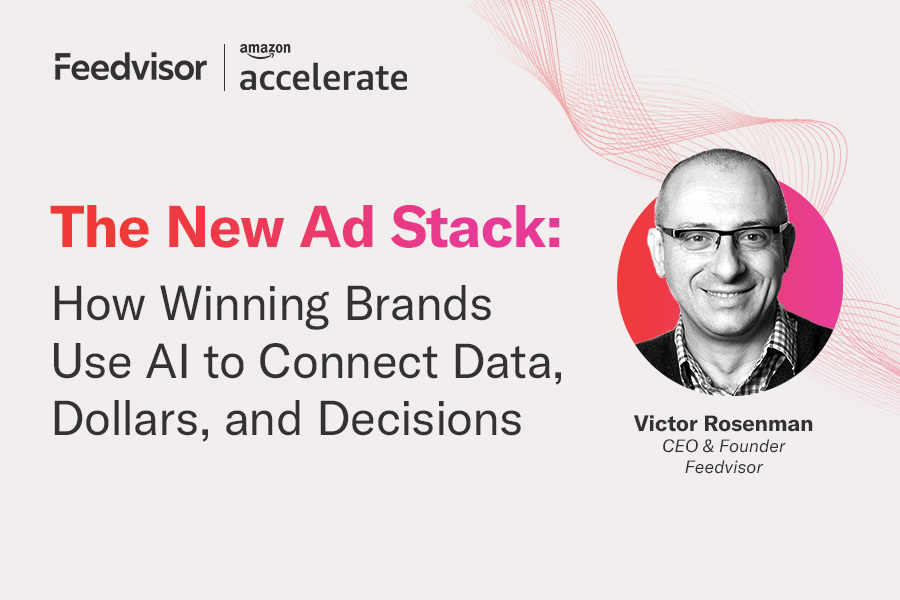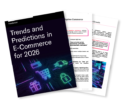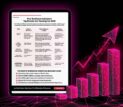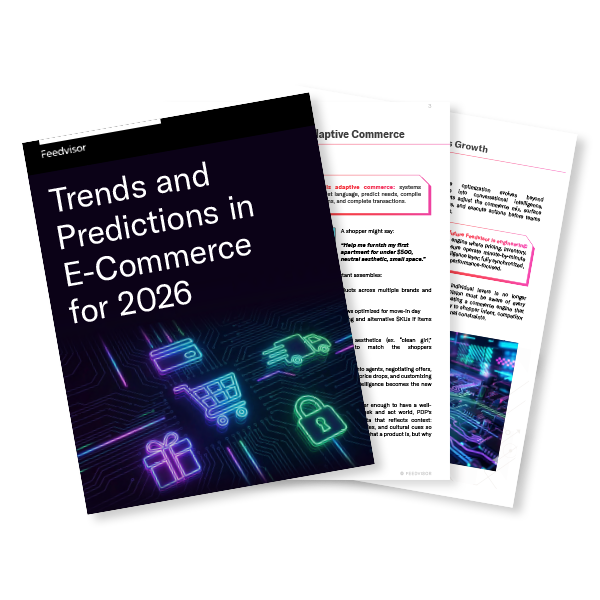
Categories
Latest Posts
Tags
Advertising Amazon Amazon Advertising Amazon Experts Amazon Listing Optimization Amazon Marketplace Amazon News Amazon Prime Amazon Professional Sellers Summit Amazon Seller amazon sellers Amazon Seller Tips Amazon Seller Tools ASIN Brand Management Brands Buy Box Campaign Manager Conference COVID-19 downloadable Dynamic Pricing Ecommerce FBA FBM Holiday Season industry news Multi-Channel Fulfillment Optimize pay-per-click Pricing Algorithm Pricing Software Private Label Profits Repricing Repricing Software Revenue Sales Seller Seller-Fulfilled Prime Seller Performance Metrics SEO SKU Sponsored Products Ads Strategy
Get the latest insights right in your inbox
Resource | Webinar

The New Ad Stack: How Winning Brands Use AI To Connect Data, Dollars, and Decisions
At Amazon Accelerate, Feedvisor CEO and Founder Victor Rosenman took the stage to talk about the challenges shaping retail media and how brands can adjust.
From rising ad costs to the evolution of organic traffic, his session dives into the realities merchants face, the strategies that actually move the needle, and where the future of agentic commerce is headed.
Read the full transcript—or watch the presentation—for a look at how to connect data, strategy, and AI to win in this new retail reality.
TRANSCRIPT
00:00
Hi, everyone. Headsets! It sounds trivial, but sometimes we forget the most important thing.
OK, I’m Victor Rosenman. I’m the CEO and founder of Feedvisor. Feedvisor is the only holistic optimization platform that basically combines advertising, pricing, inventory, and all other retail aspects to help you achieve performance that can really drive your performance to the next level.
Feedvisor is available in two main models. It’s available as a software platform that you can use in-house, which is used today by larger sellers and brands on Amazon. It’s also available in an agency-like model, where you partner with us, and we help you manage your campaigns, build your pricing strategies, and develop strategies for overall optimization.
What we’re going to discuss today is a few things. First, we’ll talk a little bit about the merchant reality—what kind of problems merchants face today, how Feedvisor approaches them, and the new ad stack we have built and why. We’ll talk a little bit about AI, the role it plays, the data, and the optimization. And we’ll tie it all together and see how you can actually win in this new e-commerce reality.
So let’s start from the very basics. It was never easy to sell on Amazon. Feedvisor has been there for the last 10 years. I’ve worked with a lot of sellers and a lot of brands, and I can really see how the whole market evolved and how the whole story unfolded.
Where we started, life was simpler. When advertising first began, it was easier. You could basically select a few keywords, place your ads, and the traffic would start to come in. You’d start to build your organic ranking, and life was good. Now, it’s not as easy as it used to be, but there are many more tools and sophisticated approaches that can make your life better.
The first challenge we all face is the increasing cost of advertising. A basic, unsophisticated approach—simply putting out keywords, targeting them, and trying to get traffic—is becoming more and more expensive. That highway is no longer the best way to reach your goals. You need a much more sophisticated, nuanced strategy, and we’ll talk about that.
The second point is that advertising alone isn’t enough. You need to understand the full shopper journey. You need to know how people are discovering your product and how they are buying it. Without that understanding, you end up wasting money and performing suboptimally.
Next is the importance of organic traffic. Its impact has shrunk. It used to be very important, but it’s less so now. Then there’s operational strategy—making sure you move traffic to the best-performing products, the ones with the most inventory, and the ones with the highest margins.
03:38 You start to add this room and that room, this passage and that passage, and it becomes a mess. Most advertising platforms today, unfortunately, have become a mess because they were designed five or six years ago. They’ve dragged all this functionality with them, and they’re no longer as relevant as they used to be.
The same thing happens with us. We started in the early days of advertising and came to the conclusion that all these things that had been important at the time are no longer important today. What matters today is different. So we built a platform from scratch, and I’m going to walk you through the approach we took and why what we did is more relevant.
The world of today can be described in a very simple way. First: data. You absolutely have to have data. Now, when I say “data,” it’s much more complex than it used to be. You need advertising data, of course. You need traffic data, sessions, and impressions. You need conversion data. But you also need other types of data: pricing data—how pricing affects conversions, inventory data and inventory flow—do we have high-velocity items or low-velocity items? What happens with the breadth of retail data, retail readiness? There are many pieces of data. If you don’t see all your data and you’re trying to optimize, it’s almost like driving on a highway with one eye closed. Do you think it’s easy to manage your Amazon business with one eye closed? It’s not. That’s why you really need to bring all of these aspects together.
05:43
You need to see all the data points. Once you’ve collected them, the next step is to have a brain. You need to process these data points and make decisions. These decisions then need to be executed. This is exactly how the Feedvisor platform is designed.
We start with the most important layer: the data/signals layer. We constantly live in a world where we receive signals—price changes, conversions, shopping behavior. What happens with various users and how they discover your product? First-batch behavior may change, last-batch behavior may change. The world is no longer the same. People discover products differently. You cannot keep advertising the same terms—it needs to be different. The signal layer defines everything: shopping behavior, intent, value, context, and engagement. You capture that.
The second layer is segmentation. You segment by audience types, discovery, first-batch and last-batch segments. There’s keyword segmentation and audience segmentation.
There are a lot of things you need to do in order to segment. You segment, you score, you need to have all your analytics and data on a segment-by-segment layer. Once you’ve done that, you can activate.
7:20
You activate the top of the funnel first, then move to retargeting. You see where you’re losing people in the funnel, then move to sponsored ads, and bring them back through differentiated bidding connected to the AMC. Finally, you have a brand store. If you have a strong brand presence and tie it all together, you deliver dynamic action. This is the 360 effect—and the 360 effect is what makes the platform unique.
Some of you want to increase growth. Targeting long-tail keywords is good, but you need to go further and look at generic keywords. You do first-batch attribution through AMC or other tools, then shift focus accordingly. If you want to go upper funnel, focus there. If you want higher margins, focus on efficiency. The same goes with pricing. For high-velocity products, slightly raising the price may not affect velocity but will improve margins.
Brand building is connected. Low-velocity items need advertising. As velocity increases, you can adjust pricing accordingly. This closes the loop.
Here’s what really happens: the central brain powers everything. It continuously receives signals, processes them, and generates conclusions on how to act. The rest of the system implements these actions. The Feedvisor advertising stack works the same way: collect signals, combine them, process them, turn them into insights, and deliver optimization actions.
09:25
One more point: walk around the floor—almost every booth has AI everywhere. When I speak with prospects or customers, I always say: ask the vendor, “Where’s your AI? Can I interact with it?” Often, the answer is unfortunately, “No.” In 95% of cases, it’s just rebranded automation. Simple automation combined with a few actions sold as AI at a high price point.
To differentiate Feedvisor, we made AI accessible. You can go directly into our platform, interact with AI, and ask any questions—just like ChatGPT or Perplexity. You can ask: “Where was the budget shift? How did this shift affect performance? Which products lost sales recently while campaigns went out of budget?” You get a detailed AI-generated answer—and you can act on it. That’s real AI.
Generative AI understands your question and gives a human-readable answer you can act on. Optimization in the platform works the same way. It uses AI to understand and act.
Moving on, everything we do results in amazing improvements for our customers.
11:25
First: full-funnel optimization. Move traffic in the upper funnel, measure it, and see that it generates new-to-brand customers, improves conversions, or moves traffic lower in the funnel. You can use generic sources, DSP, or sponsored display.
Second: combining pricing and advertising drives remarkable improvements. You make money on items previously underpriced, invest in brand building, and generate more traffic. Combined, it’s powerful.
Third: creating highly granular audiences, maintained today by the AMC, leads to substantial performance improvements.
So, to combine it all—it really comes down to your success. It really comes down to the three pillars.
You need to have access to all the data. The data comes in continuously, it changes. The retail data is changing, the traffic is changing, the analysis is changing. You need to be able to capture these patterns.
Then it goes to the central brain. The brain processes these changes. This is exactly how we as people do it. This is exactly how AI works; AI works in a very similar way to humans. This is why it’s called the generative AI. It responds in a very similar way to human response. We know to process the data, we know to make sense of data, and we know to create actions.
And we act through our body, we act through our thinking, we act through our writing. The same exact thing happens in the AI driven software that runs through pricing actions. It runs advertising actions. It gives you inventory recommendations. It helps you make decisions— decide which items you want to buy, give you a prediction.
This is the true AI. The true AI is the one that you experience through chatGPT or through perplexity. It should be exactly the same when you’re working with the Amazon platform. It’s not different.
13:36
You just need to level up. And finally: where it’s all headed. What’s the future?
First of all, definitely AI. This leads to agentic commerce. Agentic commerce means AI acts behind the scenes, with multiple engines interacting with one another. One engine focuses on pricing optimization, another on advertising optimization, and another monitors inventory levels. They can all communicate with each other—it’s very easy, and they do.
They communicate in the same way you interact with ChatGPT for queries. This is exactly how we interact with the AI, and this is how the AI engines communicate with one another.
Then there’s automation. You should spend less time on manual work. Your manual work should be strategic. You should clearly understand where your focus should be: should you focus more on the long tail, the short tail, or on brand-building activities that generate additional volume?
Or you can focus more on conversion—something that drives higher efficiency. These are your levers; this is how you decide the direction of your business. It’s your decision, and the way you choose determines your path. If you want higher efficiency, you implement higher efficiency—but that may slow down growth. If you want the opposite, that’s fine too. It’s possible. That is your decision.
This is where strategy comes in. You define the strategy, it is translated into action, and then the strategy is executed automatically.
So, to sum it up: never operate in silence.
15:09
Never drive with one eye closed. It’s not helpful; it’s actually harmful to your business. Rely more on the AI. Don’t be afraid. If you want to know whether the AI is doing the right thing, ask it. Ask the question. See how the AI answers. If it doesn’t answer well, it may be a sign that something needs to be rethought. But if it does answer well, you’re in a good spot. Apply audiences, do segmentation, measure, measure, measure. And finally, connect everything and win. Thank you very much.




